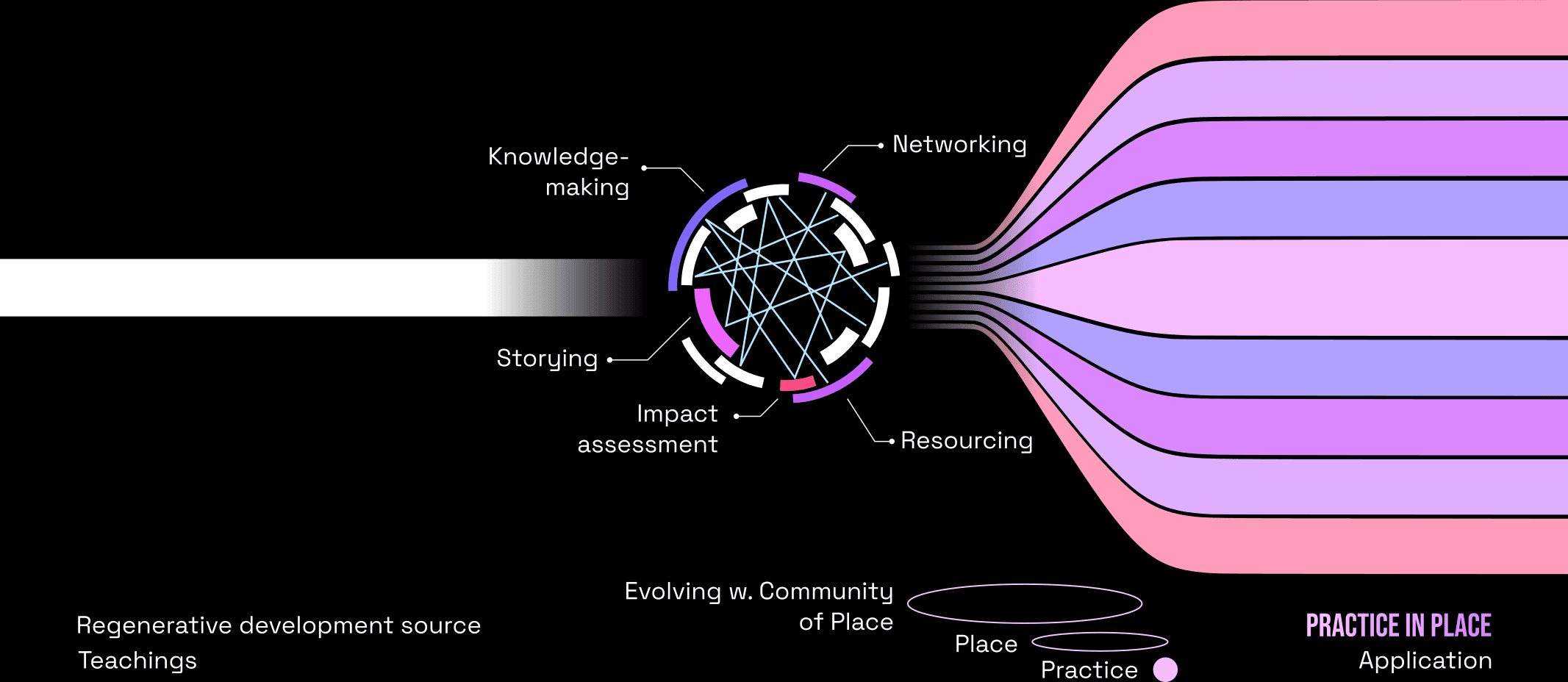
what is the potential of unfolding the potential of a place through its community of practice?
each community has to ask itself some questions, such as (borrowed from the Regenesis frameworks):
- What is the inherent potential of this place?
- How can we be of service to it?
- What is this place asking of its community (to become more of itself?)?
These are at the heart of every community.
By developing an enactment process, we’re aiming to align tech innovation with the unique context of their place, and design from a living systems paradigm, where the experiential learning process itself is the experimentation by which participants embody a potential system state and can use that collective insight to generate a precise intervention.
The term enactment refers to the active, lived processes through which systems, knowledge, and ways of organizing emerge. Rooted in embodied cognition and systems thinking, enactment emphasizes that systems are brought into being through interaction—they don’t pre-exist as static entities but arise through the collective practices of their participants. This idea is inspired by theorists like Evan Thompson, Francisco Varela, and the principle of autopoiesis, which highlights the self-organizing and self-sustaining nature of living systems.
Enactment describes how new social structures—such as governance models or economic systems—are co-created by the actions, relationships, and innovations of participants in collaborative spaces. For example, the civic infrastructures we help develop are not imposed from the outside but are enacted through self-organizing practices, such as experimenting with governance frameworks like sociocracy or developing Web3-based currencies. These new systems emerge dynamically, shaped by the interactions and feedback loops among participants, aligning with the broader principles of living systems.
By focusing on enactment, we emphasize the role of practice-based approaches in systems change, where the collective engagement of people co-creates the conditions for new societal infrastructures to emerge. Through this lens, evaluating becomes essential to make sense of the value generated by these processes, balancing innovation with reflection.
These three steps allow us to see the essence of community and place, and consequently the design of the action-learning journeys and evaluating protocols that gauge the impact contextually.
- Essence of Place<//>Community: All sorts of knowledge lie within
- Who are the main caretakers of the community?
- Once they are acknowledged, especially the history of the community, its elders and current young leaders
- Bring in conversation around fireplace to create a timeline (process infrastructuring) of the most important events that have shaped that community. For ex:
- When was it settled?
- How was is settled?
- Who took care of it?
- How did people start living there?
- Migration? Crisis?
- What are the old structures or ways that are not serving this place anymore?
- Towards what direction are the seeds of the emergent future coming into being?
-
Organising to be of Service to this Essence: What is the right means for assembling this particular cohort of players?
- What are the individual and collective strategies we need to design?
- What are the reference points that demonstrate that the future is being anchored to the present moment? (walking the right path)
-
How do we Learn through Time: The learning process must be fed and sustained, so it learns and evolves and become more of itself.
- What would it take to learn through time?
- What would it take to assess that the work being done has a positive impact on place and community?
- How do we measure ‘progress’? How do we understand sustainability and evolution?
What are the communities of practice patterns that we can observe? What do these patterns say about the process? How do these patterns speak to the ecosystem? What can they show us?
Onboarding Call Series
In the lead-up to the intensive, we are will organise a call series to begin aligning participants around the purpose of working on a future evolved version of the place which the hub is hosted in.
These calls are meant to prime participants to participate more fully, with more vitality. The calls will be designed to discuss and make sense of the insights generated from the assignments that participants are required to complete before/after each call. These assignments are designed for participants to start sensing into their place.
It’s important that through these calls we grow a kind of energy field - a social container - that will support us in our work going forwards.
